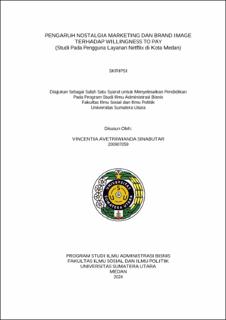Pengaruh Nostalgia Marketing dan Brand Image terhadap Willingness to Pay (Studi pada Pengguna Layanan Netflix di Kota Medan)
The Influence of Nostalgia Marketing and Brand Image on Willingness to Pay (Study of Netflix Users in Medan)

Date
2024Author
Sinabutar, Vincentia Avetriwianda
Advisor(s)
Simanjorang, Feronica
Metadata
Show full item recordAbstract
Nostalgia marketing refers to a marketing technique that leverages elements of the past. This strategy aims to evoke memories, triggering emotional responses that influence consumers' willingness to pay for a product. Netflix, as one of the major companies with a strong brand image, also employs nostalgia marketing strategies. Brand image represents the perception formed in consumers' minds regarding a particular brand.
This study aims to examine the influence of nostalgia marketing and brand image on willingness to pay. The influence of nostalgia marketing and brand image will be analyzed both partially and simultaneously in relation to the willingness to pay of Netflix users in Medan.
This research used a quantitative approach with an associative design. The population of this study consists of Netflix users in Medan, with a sample size of 96 respondents, determined through purposive sampling. Data collection techniques include primary data, obtained through direct distribution of questionnaires, and secondary data, gathered from literature studies. The analysis methods applied are validity tests, reliability tests, classical assumption tests, multiple linear regression, partial tests, simultaneous tests, and determination tests, all processed using SPSS software.
The results of this study indicate that Nostalgia Marketing (X1) and Brand Image (X2) have a significant partial and simultaneous effect on Willingness to Pay (Y). The determination coefficient test results show a strong relationship between nostalgia marketing and brand image, with an R-value of 0.762. Based on the Adjusted R Square value, it is shown that the variables nostalgia marketing and brand image contribute 57.2%, while the remaining 42.8% is influenced by factors outside of this research model.
Collections
- Undergraduate Theses [1456]
